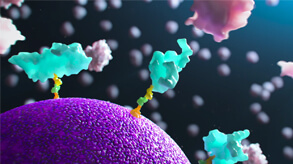Unlocking cancer insights: SomaLogic-EPIC study partnership reveals how lifestyle choices impact risk
What is EPIC?
Initiated in 1993, the European Prospective Investigation into Cancer and Nutrition (EPIC) study stands as one of the largest studies in the world aimed at understanding the risk of cancer and other chronic diseases. EPIC is a collaborative effort between Imperial College London, the International Agency for Research on Cancer (IARC), an agency of the World Health Organization (WHO), and more than 20 European institutes that follow >500,000 participants from recruitment through to today across 10 European countries.
Having provided important insights into the relationship between diet, environmental factors, and the incidence of cancer, EPIC has been crucial to understanding how lifestyle influences risk of chronic disease.
Beyond genetic factors
Proteomics holds tremendous potential to surpass the constraints of genetics-based studies by giving researchers a real-time way to understand chronic diseases. Unlike genes, proteins respond dynamically to environmental and lifestyle factors, making them invaluable indicators of disease development. Proteins are also the target of nearly all currently available drugs – leveraging the specific interactions between small molecules and target proteins to modulate biological pathways and treat various diseases.
This transition from genetic to proteomic focus sets the stage for a deeper exploration into disease mechanisms and the development of more effective treatment strategies. But in order to analyze data from diverse populations, such as EPIC, researchers need a scalable platform that gives them the largest possible view of the human proteome. This is why the SomaScan® Assay, a high-plex, high-throughput proteomics technology recently expanded to enable 11,000 protein measurements, is ideal. It’s also why SomaLogic was named the first commercial entity to partner with EPIC to measure plasma proteins from participants.
With the ability to find patterns across thousands of participants in large cohort studies, researchers can discover clues to how – and when – diseases develop. The goal is to identify people at the highest risk of future disease, so that prevention, screening – and even intervention – can happen earlier in a person’s life, when chances for survival or curative therapy are greater.
Using the SomaScan Platform to unlock precancerous insights
Towards this goal, SomaLogic assessed ~7,000 proteins from 14,700 banked plasma samples from individuals who were cancer-free at enrollment in EPIC, totaling >103 million protein measurements using the SomaScan® 7K Assay v4.1. During the 20-year period following enrollment, >6,500 people developed one of 50 types of cancer.
The unique quality of this dataset is that it provides unparalleled proteomic information on individuals before they developed cancer, which provides incredible insight into understanding disease origin. Since we already know that lifestyle and environment contribute more to individual cancer risk than genetics, there’s great potential to save lives through developing early assessment strategies.
More proteins = More clues
The math is simple. The more protein targets you can analyze, the more patterns you can find and the more biomarkers you can discover.
The SomaScan Assay, which is powered by Slow Off-rate Modified Aptamer (SOMAmer®) Reagents, gives researchers an unequaled view of the human proteome. When it’s used to analyze samples from thousands of people in large population-wide studies, like EPIC, researchers have greater power to discover new biological insights.
To see the impact of using an assay backed by a large menu of proteins, see Figure 1 below. In this graph of data from using the SomaScan 7K Assay, unique proteins that differed significantly (FDR <0.1) among women who went on to develop breast cancer are compared to participants who did not.
If researchers had used the nearest competitor platform, <42% of significant proteins would have been identified. If researchers had used prior assay versions – the SomaScan 5K Assay (with 5,000 proteins) and the SomaScan 3K Assay (with 3,000 proteins), they would have identified 70% and 20%, respectively.
By using the SomaScan 7K Assay, researchers had access to 7,000 proteins – giving them a broad view. The newest assay version – the SomaScan 11K Assay – provides an even more comprehensive view with an unprecedented 11,000 protein measurements.
These findings were consistent across the top five most common cancers analyzed by EPIC researchers: prostate, lung, colorectal, and stomach. What’s more, the SomaScan Assay identified unique sets of altered proteins specific to each cancer type, which underscores its capability for identifying cancer-specific biomarkers.
Bottom line: When it comes to seeing the whole picture of cancer risk, expanded content = expanded understanding.
Find hidden clues across every major biological pathway
Cancer often affects multiple and distant organ systems. Foundational to understanding cancer etiology is discovering which biological pathways are most influential in disease progression.
The SomaScan Assay is the industry-leading proteomics platform that covers every major biological pathway. Figure 2 below shows a selection of pathways that were enriched with proteins significantly altered in cancer-free women in the EPIC study who went on to develop breast cancer, compared to those who did not.
The above figure illustrates how roughly two times as many proteins per pathway were identified using the SomaScan 7K Assay (dark blue) as compared to the closest competitor platform (gray). Furthermore, this figure highlights the proportional increase in pathway coverage with each SomaScan Menu expansion – from the earliest menu of 1,300 proteins (shown in light blue).
Pathway analysis of breast cancer indicates enriched pathways that overlap among cancers (endometrial, prostate, glioma, and pancreatic, for example) and can highlight processes occurring long before any symptoms of disease occur.
Another benefit of superior pathway coverage is the potential for novel biomarker and drug target discoveries. Of the top-10 ranked proteins that differed between post-menopausal women who developed breast cancer compared to those who did not, 30% of the proteins discovered using the SomaScan 7K Assay were not available on the previous SomaScan 5K Assay menu. Of note, each of these proteins is a drug target under investigation for treatment of Alzheimer’s disease, anemia, and leukemia.
Pioneering cancer risk insights
The SomaLogic-EPIC partnership is producing groundbreaking insights into the link between lifestyle, environment, and cancer risk. The EPIC study’s two-decade span and extensive participant pool, combined with SomaLogic’s advanced proteomics platform, have uncovered significant protein differences associated with various cancers before their onset.
Additionally, the comprehensive proteome coverage across different cancer types makes it possible for researchers to explore more pathways than other methods and reveal promising avenues for risk stratification and potential drug target discoveries.
This partnership marks a significant milestone in cancer research, with implications for advancing preventive strategies and understanding the complexities of cancer development as SomaLogic’s aptamer-based technology continues to grow.
Learn more about our partnership with the EPIC study and how the entire SomaScan Platform could deepen and accelerate your community-based proteomics research.
Additional resources for cancer research
High-plex protein profiling for cancer research
The SomaScan® Assay profiles thousands of proteins in a 55-μL blood sample and efficiently detects low-abundance proteins in complex biological samples.
SomaScan 11K Assay Tech Note
This technical note provides background on the platform itself, as well as performance metrics for the SomaScan 11K Assay v5.0.
SomaScan Menu
Accelerate your discovery by accessing our 11,000 protein target database – the industry’s largest menu of analytes.
References
- Wu S, Powers S, Zhu W, Hannun YA. Substantial contribution of extrinsic risk factors to cancer development. Nature. 2016 Jan 7;529(7584):43-7. doi: 10.1038/nature16166. Epub 2015 Dec 16. PMID: 26675728; PMCID: PMC4836858.
- Cordova R, Viallon V, Fontvieille E, Peruchet-Noray L, Jansana A, Wagner KH, Kyrø C, Tjønneland A, Katzke V, Bajracharya R, Schulze MB, Masala G, Sieri S, Panico S, Ricceri F, Tumino R, Boer JMA, Verschuren WMM, van der Schouw YT, Jakszyn P, Redondo-Sánchez D, Amiano P, Huerta JM, Guevara M, Borné Y, Sonestedt E, Tsilidis KK, Millett C, Heath AK, Aglago EK, Aune D, Gunter MJ, Ferrari P, Huybrechts I, Freisling H. Consumption of ultra-processed foods and risk of multimorbidity of cancer and cardiometabolic diseases: a multinational cohort study. Lancet Reg Health Eur. 2023 Nov 14;35:100771. doi: 10.1016/j.lanepe.2023.100771. PMID: 38115963; PMCID: PMC10730313.
- Molina-Montes E, Ubago-Guisado E, Petrova D, Amiano P, Chirlaque MD, Agudo A, Sánchez MJ. The Role of Diet, Alcohol, BMI, and Physical Activity in Cancer Mortality: Summary Findings of the EPIC Study. Nutrients. 2021 Nov 28;13(12):4293. doi: 10.3390/nu13124293. PMID: 34959845; PMCID: PMC8709081.
- Fontvieille E, Viallon V, Recalde M, Cordova R, Jansana A, Peruchet-Noray L, Lennon H, Heath AK, Aune D, Christakoudi S, Katzke V, Kaaks R, Inan-Eroglu E, Schulze MB, Mellemkjær L, Tjønneland A, Overvad K, Farràs M, Petrova D, Amiano P, Chirlaque MD, Moreno-Iribas C, Tin Tin S, Masala G, Sieri S, Ricceri F, Panico S, May AM, Monninkhof EM, Weiderpass E, Gunter MJ, Ferrari P, Freisling H. Body mass index and cancer risk among adults with and without cardiometabolic diseases: evidence from the EPIC and UK Biobank prospective cohort studies. BMC Med. 2023 Nov 23;21(1):418. doi: 10.1186/s12916-023-03114-z. PMID: 37993940; PMCID: PMC10666332.
- Norat T, Bingham S, Ferrari P, Slimani N, Jenab M, Mazuir M, Overvad K, Olsen A, Tjønneland A, Clavel F, Boutron-Ruault MC, Kesse E, Boeing H, Bergmann MM, Nieters A, Linseisen J, Trichopoulou A, Trichopoulos D, Tountas Y, Berrino F, Palli D, Panico S, Tumino R, Vineis P, Bueno-de-Mesquita HB, Peeters PH, Engeset D, Lund E, Skeie G, Ardanaz E, González C, Navarro C, Quirós JR, Sanchez MJ, Berglund G, Mattisson I, Hallmans G, Palmqvist R, Day NE, Khaw KT, Key TJ, San Joaquin M, Hémon B, Saracci R, Kaaks R, Riboli E. Meat, fish, and colorectal cancer risk: the European Prospective Investigation into cancer and nutrition. J Natl Cancer Inst. 2005 Jun 15;97(12):906-16. doi: 10.1093/jnci/dji164. PMID: 15956652; PMCID: PMC1913932.
- Worldwide cancer data. World Cancer Research Fund International. https://www.wcrf.org/cancer-trends/worldwide-cancer-data
More blogs
BlogHow Blood Proteomics Is Accelerating Neuro Drug Discovery
Explore how researchers are using blood-based proteomics – including data from the Global Neurodegeneration Proteomics Consortium (GNPC) – to uncover new protein signatures, genetic risk associations and mechanistic insights into aging and neurodegeneration.
BlogGNPC Neurodegeneration Proteomics Dataset
On July 15, 2025, the Global Neurodegeneration Proteomics Consortium (GNPC) published four open‑access papers unveiling the largest disease‑specific proteomic resource ever assembled.
BlogIndependent study validates the SomaScan Assay as the most precise and comprehensive plasma proteomic platform
A recent independent study by Alkahest, published as a preprint on bioRxiv1, compared the technical precision and performance of multiple plasma proteomic platforms using a common set of samples.





